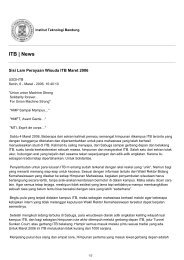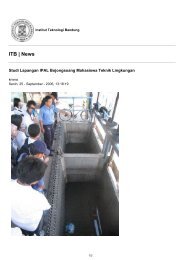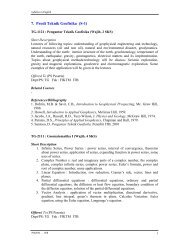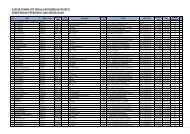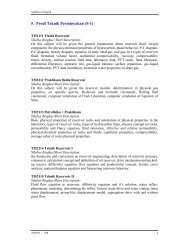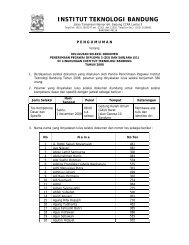1. Prodi Teknik Geologi (S-1) - ITB
1. Prodi Teknik Geologi (S-1) - ITB
1. Prodi Teknik Geologi (S-1) - ITB
Create successful ePaper yourself
Turn your PDF publications into a flip-book with our unique Google optimized e-Paper software.
Syllabus in English<strong>1.</strong> <strong>Prodi</strong> <strong>Teknik</strong> <strong>Geologi</strong> (S-1)GL 10T1 Concept of Technology.Development of science, technology and art occurs since the existency of human being,until now and until the future, and it is based on human creativity to create a better life.The development is supported by the ability of human to understand model, system,feedback, stability, decision making, and optimation. The application of science,technology and art, also development strategic of industry, relates to the invention andinnovation of human life. Understanding and application of HKi is a part of this course.GL-1101 Introduction of Earth Sciences and Mineral Technology (2 SCU)This course discusses about the born of the Earth sciences and its development, history ofideas about the Earth, Earth as part of the solar system, Earth as a solid matter (structureand composition), atmosphere, and waters (seas and oceans). The unique condition of thegeology of Indonesia is also explored. Other topics discussed in this course are Earth asthe source of mineral resources and energy, Earth hazards, exploration technology formapping the Earth resources, mining system and mineral management, and the explorationand exploitation technologies for oil, gas, and geothermal.GL-1211 Introduction to Physical Geology (3 SCU)Introduction to physical properties and exogenous processes in the Earth crust, Earthlayers, and rock forming Earth crust, weathering process hydrology system, erosion andsedimentation, Earth morphology and the process causing the morphology.GL-1241 Mineralogy (3 SCU)To give an understanding to students about the basic knowledge of crystallography andmineralogy. To study about external form and how to illustrate in two dimensions usingstereography projection method. Also to study physical properties and mineral chemistry,mineral classification and its association with other minerals to form some variations ofrock.GL-2012 Tectonophysics (2 SCU)This course is a combination between Dynamic Geology and General Geophysics courses(1998 curriculum version). Discussion about Earth dynamics in particular the endogenprocesses. This course also includes basic understanding about tectonics, history anddevelopment about continent and ocean theories, seismicity and Earth structure, formationof volcanoes, Earth crust deformation, and mountains formation.GL-2051 Sedimentology and Stratigraphy (3 SCU)This course consists of Sedimentology and Stratigraphy.Sedimentology: it will discuss about the basic of sedimentary rock, i.e. the formation ofsedimentary grain, grain transportation, and grain sedimentation. It will also discuss aboutsediment and its association in a certain depositional environment; sedimentation role inyielding coals; classification of sedimentary rocks and the influence of tectonic inspreading the sedimentary rocks.FIKTM - <strong>ITB</strong> 1
Syllabus in EnglishStratigraphy: to discuss the basic understanding of the concept, theory, and principles instratigraphy; concept about time; method to reconstruct rock strata (measuring section);stratigraphic unit nomenclature; correlation between strata and other rock units; geologicaldiscussion based on correlation section.GL 2121 General Hydrogeology.The basic of hydrogeology, meteoric cycle, rain and surface water as source ofgroundwater, aquifer system, exploration techniques, drilling, hydrodynamic, numericalsimulation, hydrochemistry, hydrogeological basin, groundwater law.GL 2122 Engineering and Environmental Geology.It is a service lecture for the student from Planology. The course introduces the study ofinter-relationship between the earth (materials and processes) and life and living things,especially human. The lecture gives the role of geological factors, that become importantpart in supporting, constrain and limitation to the development of the regions,environmental changes, as well as geological hazards.GL-2141 Petrology (3 SCU)To deal with all kind of rocks found in the Earth, characteristics of every rock, and rockforming processes. Finally, the students will be able to describe the rocks (mineralogy,texture, and to name the rock).GL-2181 Paleontology (3 SCU)To discuss about fossil and fossilization processes, the meaning of space and time in theevolution and paleontology, the use of paleontology/fossils in geology. Quantitative andqualitative methods in paleontology (biometry) will also be discussed in this course. Themeaning of fossil in the formation of geological time scale and invertebrate macrofossilsystematic. Identification of fossils and to study the characteristic of fossils that can beused to determine the geological ages.GL-2191 General Geochemistry (2 SCU)To discuss, to describe, and to determine the abundance of element and isotope in theEarth relatively and absolutely; to describe about distribution and migration of elements invarious parts of the Earth particularly in minerals and rocks in order to understand theprinciples that control the distribution.GL 2231 Computational Geology.Basis of computational work and computer aplication in geology; basis of hardware andsoftware in computer and programming language; knowledge on deterministic parameteranalysis and basic statistics in geology. The lecture content is : Introduction to QBasiclanguage & flow chart, Introduction to commands in computer, Sub-Routine, Graphic,Numerical solution for non linear equation, Numerical approximation and integration,FIKTM - <strong>ITB</strong> 2
Syllabus in EnglishSolution of Matrix Equation, Probability, Markov chain, Single linear and quadraticregressions, and Multiple linear regressionsGL 2241 Volcanology and Geothermal.This lecture focuses on tectonic setting, magma generation, eruption, volcanoclassification, disasters mitigation, heat flow, chemical-physical aspects, volcanostratigraphy,and field research method, also discusses several aspects, such as relationbetween volcano and mineralization processes and energy, agriculture tourism, etc.GL-2281 Historical Geology (2 SCU)Hypothesis about the formation of the Earth, development of the theory about the Earthbased on the contraction theory; and other theories such as geosyncline, continental drift,convection current, and plate tectonic. Evolution of the Earth from its formation up toQuaternary and the economical aspect. Some examples from Indonesian areas will begiven. The development of life in the Earth in space and time.GL-2291 Exploration Geochemistry (2 SCU)Explanation about the history of inorganic geochemical exploration history; determinationabout primary geochemical environment; secondary environment in particular about rockweathering; element enrichment and its dispersion system; basic principles of geochemicalexploration; the use of pathfinder elements and anomaly of the elements; geothermalgeochemistry; pollution aspect and pollution problems.GL-3051 Petroleum Geology (3 SCU)The general discussion will include petroleum system aspects, i.e. source rock andmaturation, hydrocarbon migration, reservoir, and trapping mechanism. Assignments willbe given to students with academical and practical aims. Examples of petroleum systemsfound in Indonesia and other countries will be used as models.GL-3111 Structural Geology (3 SCU)To discuss about geological structure, tectonics, and their processes. Deformation onrocks, kinematics and rock structure; principles of stress and strain forces; description andelement analyses of joints, faults, folds, regional structural and basic tectonics.GL 3121 Introduction to Engineering Geology.Knowledge of engineering concept and its relation to geological concept, terminology andclassification of engineering geology for geology material, exploration method andmeasurement for engineering purpose and hazard mitigation. (Served for non geologystudent).FIKTM - <strong>ITB</strong> 3
Syllabus in EnglishGL-3141 Petrography (3 SCU)Discussion will include:• Optical properties of the rock forming minerals based on polarized light in thetransparent medium• Mineral identification based on its optical properties• Classification and grouping of rocks based on their genesis: igneous, pyroclastics,sedimentary, and metamorphic rocks• Introduction to rocks and how to name them based on their petrography properties:texture, structure, and mineralogy.• Identification of petrography properties using polarized microscopeGL-3151 Well Log Geology (2 SCU)To discuss about some logging techniques, such as mud logging, wireline. Some wirelinesand their uses; log lithology, log porosity/density, log resistivity. Formation fluid contentanalysis, porosity calculation, water saturation, threshold calculation, and so on.GL-3152 Coal Geology (2 SCU)This course explains about coals as mining product from the geological aspect, such ascoal sources, the requirement of coal formation, and the organic matter found in coal.Parameters on coal quality and coal classification based on these parameters. Other qualityparameters for specific coals, e.g. steam coal, cokes, coals for cement factory, and forbricket. Exploration method and reserve classification will also be discussed. In briefabout some factors used in a feasibility study and environmental impact of the coalmining.GL-3161 General Micropaleontology (3 SCU)Introduction and discussion about microfossil types and the use of them in geologicalexploration. The stress will be given to the introduction of foraminifera microfossil.Application of the microfossils for determining geological ages and depositionalenvironment and biostratigraphy correlation.GL 31S1 Referat/Seminar Based on Reference Study.A short lecture in the beginning 4 weeks gives the basic knowledge of a geologicalpresentation. The following weeks are student seminar weeks; the student should resumesome reference studies and present it in front of lecturer and other studentsGL-3201 Field Geology (3 SCU)This course comprises two methods: theoretical and field courses. The field camp is inKarangsambung area, Central Java. In the field, the students will be taught about thestandard field methods used in geological research. The course begins with fieldorientation, observation technique, geological traverse, measuring section, structuralanalysis, and is concluded with field geological mapping including synthesis in the finalreport format.FIKTM - <strong>ITB</strong> 4
Syllabus in EnglishGL 3221 Introduction to Engineering Geology.Knowledge of engineering concept and its relation to geological concept. The lecture givesclassification of rock and soil for engineering purpose, methods of analisis andmeasurement of engineering properties of, and its application. Exercise and laboratoriumwork are given. The course also gives basic engineering geology formulae and itsapplication, relation between engineering characteristics and geological condition orprocess, and management of destructive processes. At the end of the course, it will begiven technique of engineering geology mapping and student seminars.GL 3222 Geomorphology.Knowledge of geomorphology concept, process and condition of morphology formation,and also basic interpretation of remote sensing for geology. Knowledge of morphologyand its stage, classification of geomorphology, method of geomorphology mapping forearth science and its application.GL-3241 Metal and Non-Metal Mineral Deposits (3 SCU)To discuss about the application of basic geology for genesis reconstruction of the mineraldeposit and industrial mineral, and their exploration concept.GL 3241 Mineral Deposit.Course Objectives is to gain an awareness and appreciation of: the variety, form, andglobal distribution of a range of important metalliferous mineral deposit types, theirregional geological and tectonic context, their geochemical and geophysical signatures, asapplicable to mineral exploration, and a basic understanding of mineral explorationpractices. It is also to gain a practical knowledge of: common ore and alteration mineralsin hand specimen and polished section, and the interpretation and description of theirtextures, and suites of ore and alteration minerals associated with different mineral deposittypes.GL 3251 Geology and Geophysics Exploration.This lecture consists of the exploration concept, followed by planning and the explorationtechniques. The exploration technique deals with the exploration stages and explorationmodel. The exploration model includes geology and geophysic models using theappropriate geology and geophysic methods commonly used, i.e. geology survey method,local geology survey, drilling exploration, seismic, gravity, geoelectricity, and magnetic.GL-3271 Geology of Indonesia (2 SCU)A knowledge about structural style of Indonesia, i.e. islands physiology, tectonicdevelopment history, application of tectonic concept and its relation with the formation ofoil basins, coals, and minerals.FIKTM - <strong>ITB</strong> 5
Syllabus in EnglishGL-32S1 Reference study II (English) (SCU)In this course students will be taught about literature search technique in the internationalliterature system, browsing and surfing in the multimedia information network system, theskill to make a resume of a literature study. Finally, the students have to prepare and torewrite a paper and to present it in English.GL-4001 Practical Training (2 SCU)This course is a medium for students who has a chance to do a job training in industries orcompanies. The student has to write a report and it will be assessed by a lecturer who hasbeen chosen as his/her supervisor.GL-4002 Special Assignment of Geology (2 SCU)This course is a medium to accommodate some temporary academic activities that have asignificant contribution to education, such as guest lecturer in various fields.GL-4011 Tectonics (2 SCU)This course discusses about movements happened in the Earth in terms of their cause andimpact in the formation of the tectonic elements, structural phenomena, deformation, andothers; introduction about hypothetical thought and theories for solving the Earth crustevolution problems.GL 4021 Geology of Bandung Basin.The course gives the knowledge of the geological aspects and conditions in the BandungBasin area. The basin itself has the boundary of the upper Citarum River basin. The lecturedescribes the Pre-Quaternary geology of Bandung area, its Quaternary aspects such asvolcanic development and processes, stratigraphy and structural geology, formation anddevelopment of the ancient Bandung Lake, and its implications to geo-archaeology,hydrogeology and environmental geology.GL 4022 Geotourism.It gives the knowledge on the development of geological aspects to the tourism industry.The lecture describes the potency of geological aspects for geotourism and its problems, aswell as constrain, in tourism. It also describes how to plan geotourism tour package, tourroute and development planning. The lecture includes the case study of some touristattractions of both already developed and not developed yet.GL 4041 Geology of Gems.The course contains information about gem localities over the world, their geologicalsetting and downstream of gem industry. The course comprise audio visual of geologygem deposits, which make the course easily understandable. In addition we included ashort workshop of gem exploration and processing.FIKTM - <strong>ITB</strong> 6
Syllabus in EnglishGL 4042 Marine Geology.This course gives phenomenon of marine geology, origin, economic potential,environment and hazard, and exploration concepts. It also gives basic of oceanography inthe relation to geology processes. The course reviews : history of marine research, basicoceanography, morphology of beach and ocean, geology of continen slope, reef, deepmarine geology, mineralisation, method of marine exploration. The lecture is given by ateam involving experts in oceanography, geology, geochemistry, and marine researcher.GL 4043 <strong>Geologi</strong>cal Hazard Mitigation.The course is the knowledge about how to understand each characters of hazards,involving some geological aspects, and how to minimize the casualties. The study willintroduce the geological aspects and processes which can cause and trigger the naturaldisasters; the definition of natural disasters, and how to anticipate the natural disasterswisely. This lecture focusses on how to live in harmony with mother nature and how tolive peacefully in a disaster area.GL-4061 Advanced Micropaleontology (3 SCU)This course contains an advance discussion in plankton and benthic foraminifera, sporeand pollen, dynoflagellate, and nannofossil, and the use of them in helping to solvegeological problems, particularly in stratigraphy, age determination, paleobathymetry,paleoecology, and paleoclimatology. Some assignments about interpretation inbiostratigraphy based on both well and field data will be given to students. Practical workwill include understanding the planktonic foraminifera particularly the biodatum forTertiary and Quaternary; large foraminifera for letter classification and benthic smallforaminifera as indicator for depositional environment. Introduction to spore and pollenfossils, dynoflagellates, and nannofossil that can be used to determine age and depositionalenvironment.GL-4091 Risk Analysis in Mineral Resources Development (2 SCU)This course contains some techniques using probabilities to handle the risk factor in therisk analysis.GL-40S1 Colloquium (2 SCU)This course is a medium for students to present his/her final project either field or nonfieldgeology in the front of some lecturers and final year students.GL-40Z1 Final Project A (6 SCU)This type A final project is based on the geological surface mapping data.GL-40Z2 Final Project B (4 SCU)This type B final project is based on the non-geological surface mapping data.FIKTM - <strong>ITB</strong> 7
Syllabus in EnglishGL-4101 <strong>Geologi</strong>cal Synthesis (2 SCU)This course is a medium to integrate some basic and applied courses in geology based onrealistic data comprising the surface and subsurface. Starting from data collection, dataprocessing, data interpretation, and synthesis, written in a scientific paper format.GL 4102 Law and Regulation of Geo-resources.Discussion on laws and regulations related to geo-resources and its relation with spatialuse management, ecosystem function, and conservation. The session will be on :Introduction, State’s ownership as constitutional basis, System of geo-resourcesmanagement in regulation, Ecosystem approach, multi and interdisciplinary analysis insystem of law on geo-resources (relationship between law and non-law), Permit system ofgeo-resources utilization and AMDAL process, Change of AMDAL to environmentalaudit system in monitoring company activities, Economis instrument and capital inregulation, Engineering design and transfer of technology in applying regulation,Perspective on national and global economics on geo-resources in development of newlaw, and discussions.GL 4103 Principles of Hydrogeological Mapping.Principles of hydrogeological mapping, mapping stages, map interpretation, indirectmapping method (geophysical methods). Student be able to understand: principles ofhydrogeological mapping, mapping stages, map interpretation, and indirect mappingmethod (geophysical methods).GL 4121 Environmental Geology.It is a part of geology, that particularly concerns to the study of inter-relationship betweenthe earth (materials and processes) and life and living things, especially human. Thelecture gives the role of geological factors, that become important part in supporting,constrain and limitation to the development of the regions, environmental changes, as wellas geological hazards.GL 4141 Geology of Geothermal.Geothermal geology reviews geothermal energy and magmatism in a tectonicenvironment. It also focuses on volcanism associating with a geothermal system usingexamples in Indonesia and overseas. Further aspect of discustion includes surfacemanifestation from an active or inactive geothermal fields and subsurface imaging basedon the geophysics measurements.GL-4191 Economics of Mineral Resources (2 SCU)This course discusses about some economic aspects of “mineral” business, such as:• Indonesian mineral industries (oil and gas, coal, metal and non-metal, geothermal)• Finance vs. accounting• Cash flow and depreciation• “Cost of Money” (PV, FV, AV)• Economic parameters (cost benefit ratio, IRR, PIR, Payback, etc.)FIKTM - <strong>ITB</strong> 8
Syllabus in EnglishGL-4192 Petroleum Geochemistry (2 SCU)Discussion in this course will include kerogen (the main material as oil and gas source),source rock which consists of source richness, organic matter types, depositionalenvironments, and some knowledge about oil and gas formation. The aims of thediscussion are for scientific and practical purposes. The practical matter include someanalysis methods used by geochemists and oil and gas industries. Biological markers andtheir use in oil exploration will also be discussed briefly. Some Indonesian real cases willbe given to the students.GL-4271 Stratigraphical Analysis (2 SCU)Analyses of genetic unit, distribution, and genetic unit geometry; analysis anddevelopment of sedimentation in the frame of basin evolution. The data used are outcrops,well-log, and seismic section processed in work-station. The stratigraphycal analysis isleading for exploration both hydrocarbon and subsurface water.GL-4281 Elective Paleontology (2 SCU)This course is design for students who would like undertake their final project majoring inpaleontology. The course topic is a tailor-made style.GL-4291 Engineering Economics Analysis (2 SCU)Teaching the fundamental concepts of engineering economy to explorationists andengineers.GL-4292 Presentation Technique (2 SCU)Explorationists always need to present their work in front of audience, e.g. a fieldgeologist presents his/her idea in proposing seismic work, drilling, new prospect, and soon. In many cases, presentation could be persuasive where the presenter aims to makehis/her proposal being accepted. This course deals with how to prepare a goodpresentation.GL-5011 Microtectonics (2 SCU)Thin section is an information source in geology and the importance is as the outcrops.However, explaining structural geology from thin section is more restricted relative to thatof the petrological aspects. Development of modern structural geology indicates thatvarious geometrical forms of structural geology can be studied through thin sections. Evenmore, a metamorphic petrologist will obtain more information regarding a relationshipbetween geological structure evolution in a thin section scale and metamorphosisprocesses. Deformed rock is a direct information source regarding geological structure thatcan be used to reconstruct tectonic evolution.GL-5012 Advanced Structural Geology (2 SCU)During the last decade, the development of structural geology has been very fast,particularly after the Continuum Mechanics concept are used widely in the Earth sciences.The development brings the structural geology into applied knowledge in industry both inFIKTM - <strong>ITB</strong> 9
Syllabus in Englishthe energy and economic mineral fields. This course discusses the application of modernstructural geology in many aspects.GL-5013 Neotectonics (2 SCU)According to history, more than 92,000 people died when Tambora Mount exploded in1815, 240,000 people died when earthquake happened in Tangshan, China in 1976, andaround 6,000 people died during earthquake in Mexico City in 1985. Another event that isnot as spectacular as mountain explosion or earthquake is tectonic process that happensslowly in a small scale such as river flow disturbance, shore uplifting, and gulf bending.Such processes can influence significantly to the economy of a country. Therefore,evaluation to the active tectonic process or neotectonics becomes critical in the human life.These disasters can be minimised, the structures can be localised and used effectively,economically, and safely.GL-5014 Fracture and Geomechanic (2 SCU)The interest to study fractures either in the surface or subsurface has increased in the lastdecade. The main reason is that fracture can increase fluid flow in the subsurface and ithas been proved in the oil industry where the production increases significantly in areservoir having an intensive fractures. Research also shows that mineral economicdeposit is generally found in area(s) with high fracture density. Fracture also has a veryimportant role in groundwater and environment especially in the waste location.Furthermore, fracture has a specific role in engineering geology, e.g. for slope stability.Therefore, knowledge about fracture is very important and this course offers the studentsto study deeper about fracture formation mechanism quantitatively.GL-5021 Geology of Soil (2 SCU)Genesis of soil, geological control, climatology control, erosion and weathering processes,soil mapping, soil engineering properties, soil mineralogy and geochemistry, and soilengineering aspects are topics to be discussed in this course.Gl 5021 Geology of Soil. .Origin of soil, geological control, climatological control, erotion and weathering, soilmapping, soil classification, engineering properties of soil, mineralogy and soilgeochemistry.GL-5041 Rock Alteration (2 SCU)Discussion will include knowledge about hydrothermal alteration, hydrothermal liquid,alteration zonation based on secondary mineral group produced. Some types of oredeposits especially gold, copper, and nickel deposits are the main discussion topics in thislecture. Introduction to altered mineral microscopically will also be taught.FIKTM - <strong>ITB</strong> 10
Syllabus in EnglishGL-5042 Petrology of Sedimentary Rock (3 SCU)Discussion will include silisiclastic sedimentary rock (sandstone and pyroclastic rock) andcarbonates. The discussion will be stressed in provenance and diagenesis of such rocks.Pyroclastics will be determined their mineralogy, texture, and classification. Forcarbonates, the discussion will be leading to oil and gas exploration. Practical andlaboratory works will accompany this lecture.GL 5043 Geostatistic.Geostatistics is the application of statistic method which relates to spatial data, boththeoretical and practical works. The course covers also geostatistic for reservoirmanagement, geostatistic in engineering such as univariate and bivariate, geostatistic forestimation and simulation. Case study will give the application of geostatistic for oil andmining companies, and geohydrology.GL-5044 Interpretation of <strong>Geologi</strong>cal Seismic (2 SCU)This lecture discusses about analysis of amplitude response on lithology and rock physicalproperties, temporal and spatial resolution, and pitfall in seismic data interpretation,structural interpretation, seismic stratigraphy, 3D seismic attribute for reservoircharacterisation.GL 5044 <strong>Geologi</strong>cal Seismic Interpretation.Amplitude response analysis for understanding lithology and rock physics, temporal andspatial resolution, pitfall in seismic interpretation. Interpretation of structure andstratigraphy using case studies of clastic and carbonate areas. Seismic stratigraphy, AVO,seismic inversions and seismic attributes to interprete reservoir conditions.GL 5045 Hidrothermal Mineral Deposit.Many hydrothermal ore deposits have been formed on and near the island arcs from theArchean to the present day and today many subaerial and submarine active geothermalsystems are active. This course summarizes the geological, geochemical and tectonicfeatures, and the evolution of various types of ore deposits and current island arc tocratone or crustal hydrothermal systems in the worl starting with Archean.GL-5045 Hydrothermal Mineral Deposit (2 SCU)This course discusses about the geology of mineral deposit in association withhydrothermal processes. The discussion is leading to the base metal mineral and theprecious stone exploration businesses. Therefore, the stress of the discussion is to thecomprehensive understanding about hydrothermal minerals genesis, trapping structure,deposit volume, their economic aspects. Some case examples discussed will be taken fromIndonesia by correlating them with the exploration strategic aspects and industrialminerals. Some hydrothermal mineral deposits that will be exampled are tin pegmatitedeposit in Bangka, porphyry copper in Freeport-Papua, Newmont Batu Hijau, LawalotoNorth Sulawesi, Sedex Sangkaropi, epithermal gold in Pongkor, Cikondang, Pangalengan,and Kelian, and so on. This course will be followed by some practical works andexcursion to the surrounding mining areas.FIKTM - <strong>ITB</strong> 11
Syllabus in EnglishGL-5051 Subsurface Geology (3 SCU)This course discusses about subsurface data processing consisting of well and geophysicaldata in order to create subsurface map.GL-5061 Applied Micropaleontology (2 SCU)This course discusses a various methods of the application of micropaleontology in somefields, such as stratigraphy (biostratigraphy and sequence stratigraphy),paleoenvironment/bathymetry, paleoceanography, paleoclimate, and others. Thediscussion will include basic concepts starting from the sampling method up topresentation of the analysed data, e.g. biozonation, quantitative biostratigraphy, wholefauna study, transfer function, modern analog technique (MAT), and stable isotopeanalyses. Every topic will be followed by case examples and assignment so that it will bewell understood by students.GL-5071 Sequence Stratigraphy (2 SCU)This lecture discusses about understanding the sedimentary basin filling evolution basedon sea-level fluctuation concept, discussion about high resolution correlation (HIRES),and the correlation between the stratigraphy and the hydrocarbon exploration anddevelopmentGL-5072 Quantitative Stratigraphy (2 SCU)This course discusses about review of some basic principles, theory and stratigraphicprinciples/laws, time and space concept, and sedimentation processes. Understandingabout basic statistic, in particular that is used in stratigraphy and sedimentology analyses.Understanding about procedure and method for sampling, quantitative biostratigraphy,quantitative lithostratigraphy, and quantitative sequence stratigraphy.GL-5081 Quaternary Geology (2 SCU)This course discusses about some problems in Quaternary geology and stratigraphy inIndonesia. The occurrence of human fossil Homo erectus and vertebrates in Indonesia andpaleoreconstruction during Quaternary in Indonesia. To understand tectonic developmentand magmatic/volcanic activities , basin development and Quaternary sedimentation inIndonesia. Application of Quaternary geology in Indonesia, in particular the archeology orculture aspects, engineering/environment and economic.GL-5082 Quaternary Geochronology (2 SCU)This course discusses:<strong>1.</strong> Several methods for age determination and the basic of Quaternary geochronology.2. Problems in Quaternary stratigraphy division in Indonesia and the importance to learnabout Indonesian Quaternary geochronology method.FIKTM - <strong>ITB</strong> 12
Syllabus in EnglishGL 5121 Numerical Simulation.Application of numerical simulation (finite difference and finite element) in geolocialproblem. Finite difference includes : Introduction: forward, backward, central differencesand grid system, Condition: boundary condition: Dirichlet, Neumann, and initial condition,Steady-state: Laplace and Poisson equation, transformation to linear equation, Solution ofmatrix equation, Transient: differential equation, transformation to linear equation,Tridiagonal matrix, Stability, convergence, and consistency, Explicit and implicit solution,Other matrix solutions: Crank-Nicholson, ADI, SIP. Finite element includes : Linear basisfunction, polynomial basis function, Stress deformation: discretization, global & localcoordinates, interpolation function, Stress deformation: minimum potential energy,Galerkin, and Potential, thermal, dan fluid flowGL-5141 Petrogenesis (2 SCU)An advance study in petrography stressing in the formation of igneous rocks.GL-5191 Mineral Chemistry (2 SCU)This course discusses about characteristics of mineral chemistry, correlation between theoccurrence of element and crystal structure, and response of mineral against chemicalstability problems in the geological processes (metasomatism, metamorphism, alteration,mineralisation, weathering). Discussion will also include product association in relationwith Petrogenesis process and economic mineral prospection. Some famous case examplesfrom Indonesia and other countries will be given.GL-5192 Isotope Geology (2 SCU)This course discusses about radioactivities, the occurrence of the radioactivity in nature,parameters influencing its intensity, and the use of the radioactivity elements orcombination of some elements to imply the petrogenesis; fluid system correlation(reservoir-source in hydrocarbons, source of water in a geothermal system) andgeochronology.GL 5221 Hydrogeology of Fracture Media.Terminology (aquifer, fracture geometry, groundwater flow), fracture genetic, typology ofaquifer system, hydrodynamic of aquifer, exploration method, fracture mapping methods(remote sensing, geology, geophysic) and method of groundwater flow tracing, analysis ofgroundwater hydrography (spring, subsurface stream), susceptibility of groundwater forpollutant, aquifer management, case study : volcanic and karst area. Students are able tounderstand: principal difference of hydrogeology in porous media and fracture media,aquifer geometry, choosing the optimum exploration technique, how to make fractureaquifer system map in 2D and 3D, how to delineate aquifer boundary.GL-5281 Larger Foraminifera (2 SCU)The aims of this course are to introduce to students in more detail about largerforaminifera (especially the marine ones) that are widely found in Indonesia, so that theycan have a better understanding about this fossil group. The discussion will includeFIKTM - <strong>ITB</strong> 13
Syllabus in EnglishPaleozoic, Mesozoic, and Cenozoic larger foraminifera. The Fusulinidae will represent thePaleozoic foraminifera, and the Mesozoic will be represented by Orbitolinidae. TheCenozoic group will be discussed in relation with Tertiary letter classification.Identification of Tertiary larger foraminifera using biometry method. Finally, ecology ofthe larger foraminifera will be discussed in their close relationship with carbonatesedimentation. The use of these fossils with non-foram such as Algae, Mollusc, and coralfor identifying reef facies.GL-5291 Soil Geochemistry (2 SCU)This course discusses about chemical role in the soil formation process, distribution, anddispersion, and the principles controlling the distribution mode and chemical dispersion.Discussion will also include soil classification, soil sampling, and the use of soil forhuman-being.GL-5292 Geothermal Geochemistry (2 SCU)This course discusses about the role of chemistry in the geothermal system, where theelement stability is disturbed in mineral or rock due to the occurrence of hot fluid in therock system. Fluid type, its chemical character and characteristics in the reservoir system(temperature, pressure, mineralogy) and geothermal exploration system (scaling,corrosion) will also be discussed. Production well evaluation will be exampled and somecase examples will be given both from Indonesia and other countries.GL 5292 Geochemistry for Geothermal.This course covers all aspects of chemistry at geothermal systems. It explains type,composition, source and distribution of geothermal fluids; and the effects of boiling,mixing and condensation to the composition of water. How to understanding of thereservoir condition is then given, followed by the behaviour of gas dan stable isotope ingeothermal systems. In the last mid semester, the course will point out : monitoring ofproduction wells, including scaling formation dan corosivity in production pipes,environmental aspects and interaction between rock and geothermal fluids.FIKTM - <strong>ITB</strong> 14




